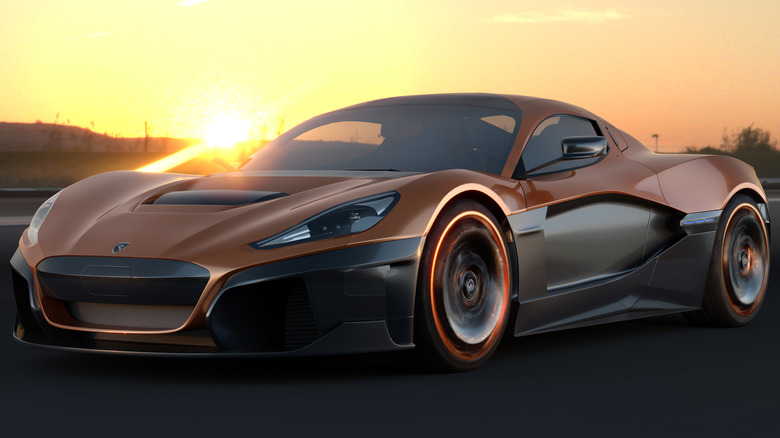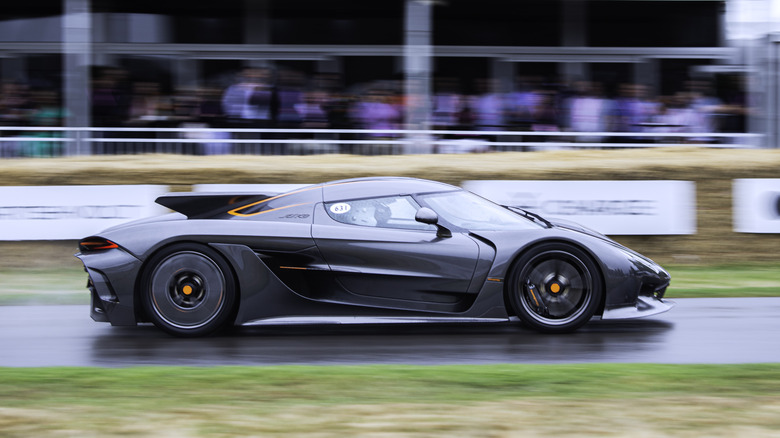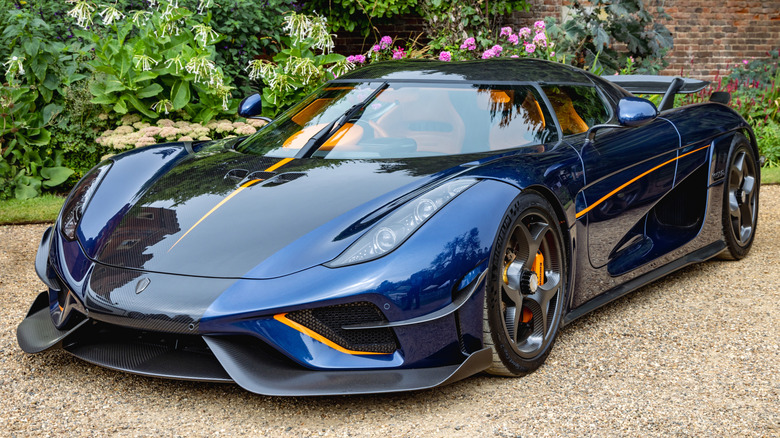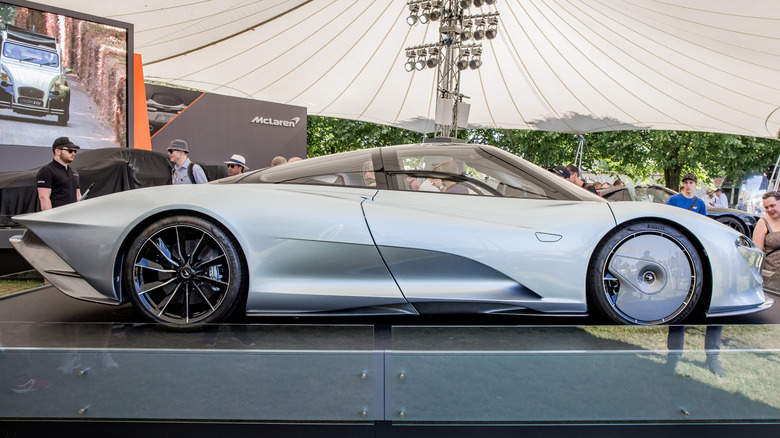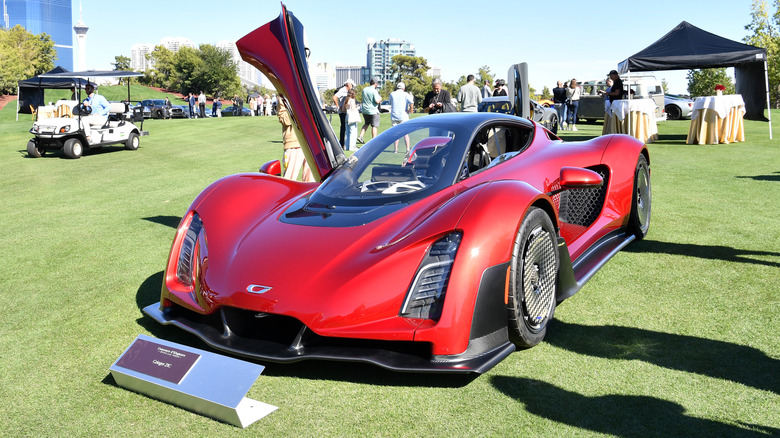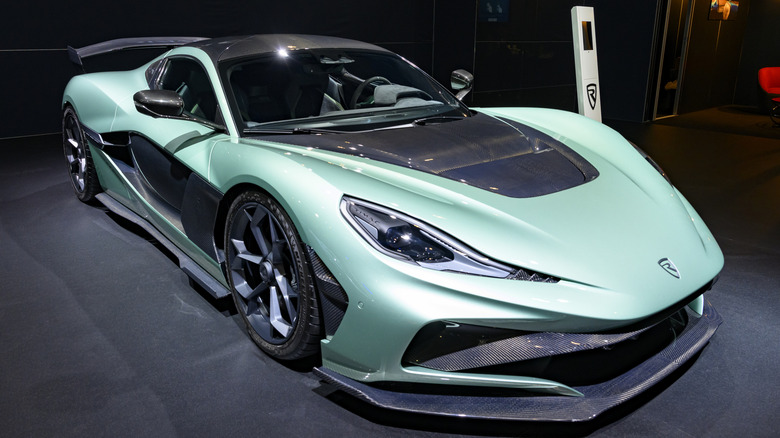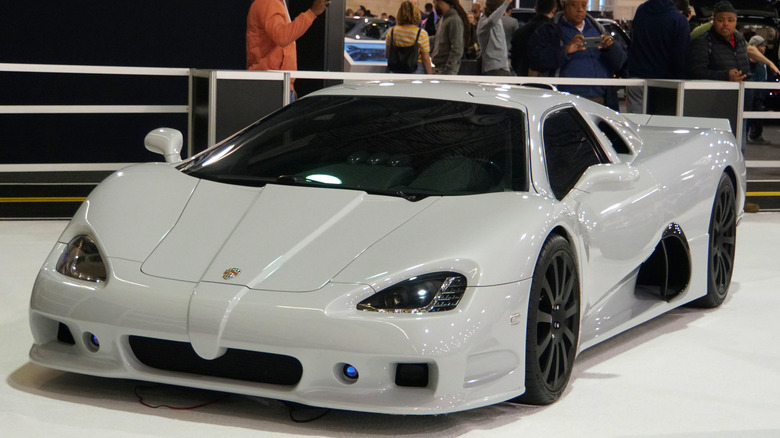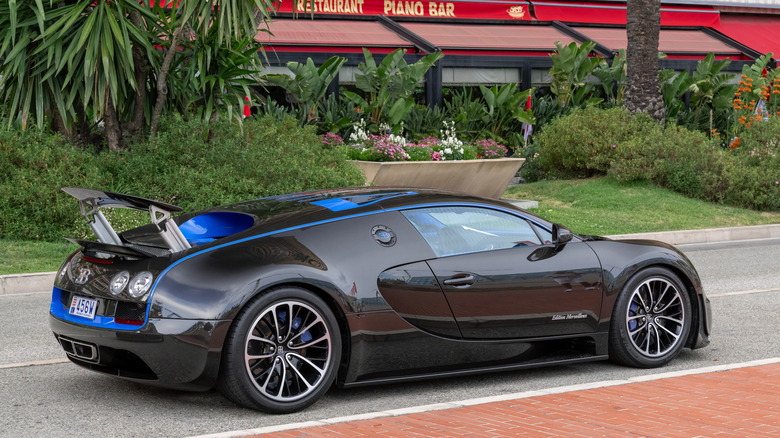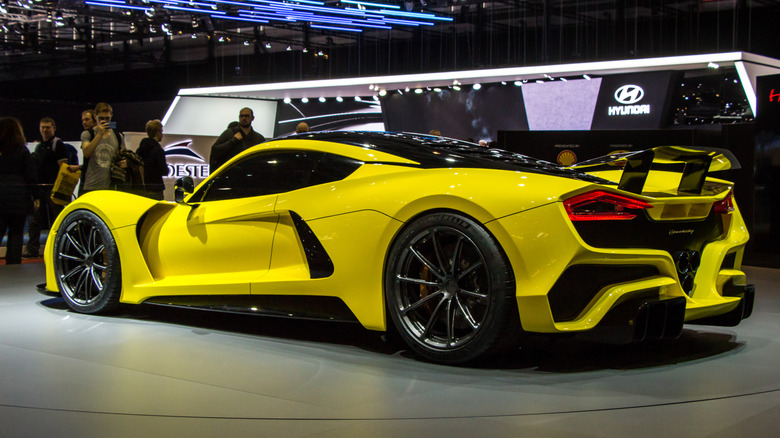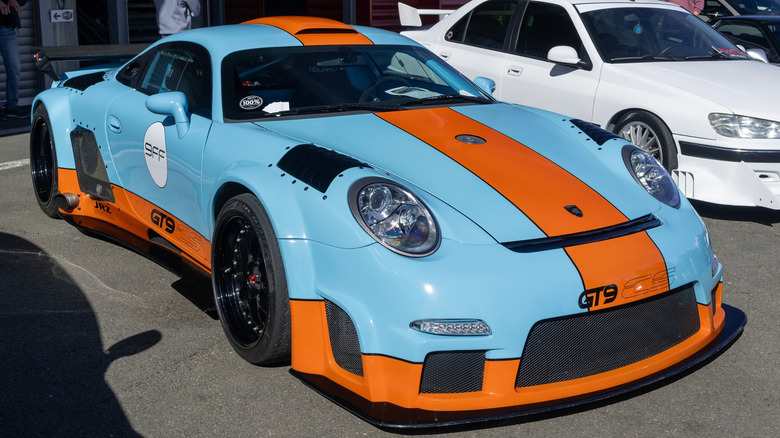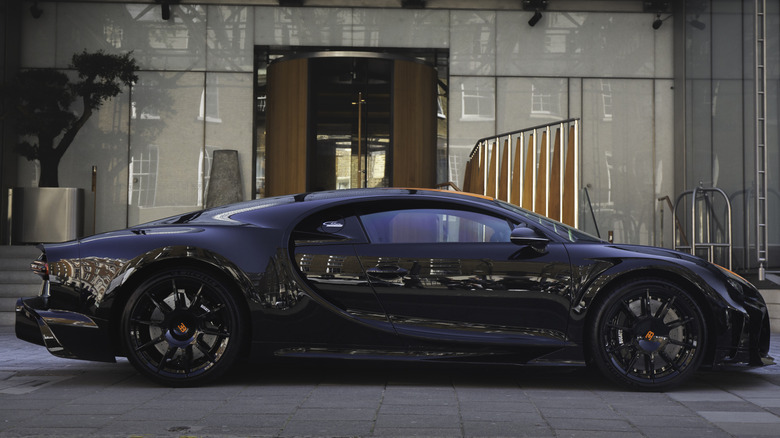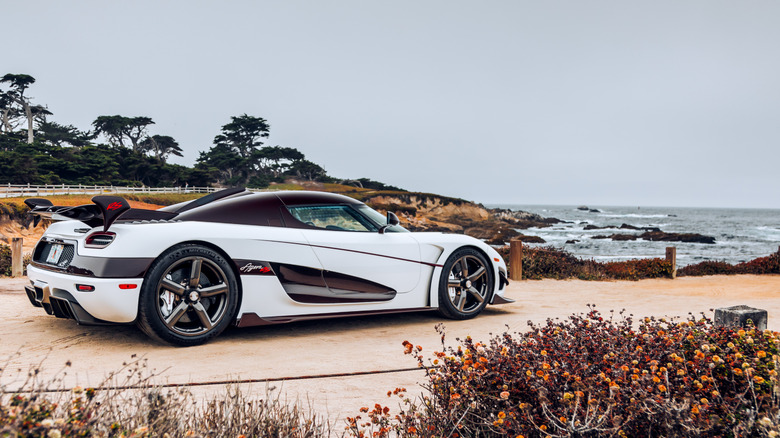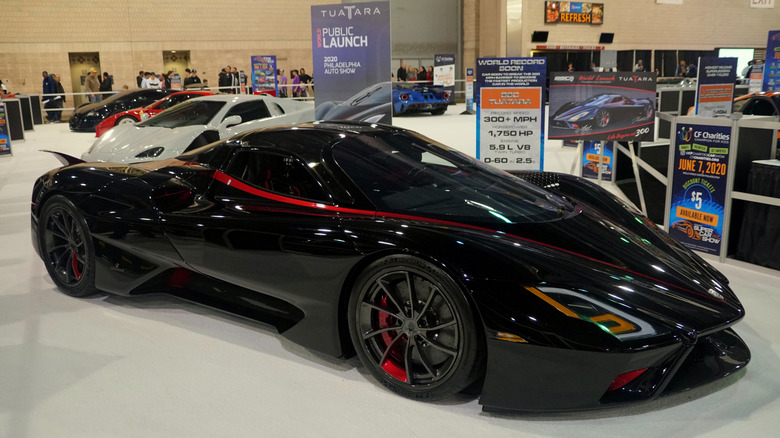These Are The Fastest Street Legal Cars Ever Built
It isn't unheard of for today's fastest street-legal cars to reach top speeds of 250 mph or more. After an exhilarating ride like that, it's hard to imagine ever being able to drive 65 mph again, let alone a grueling, snail's-pace of 25 mph. Supercar makers all over the world are constantly competing for the fastest production car title, pushing the industry to test the limits in every aspect of new supercar design.
What would it feel like to get behind the wheel of one of the world's fastest cars that can legally drive on the street? And which of these marvels of engineering would make the best option to test out if given the opportunity? That's a tough question to answer. After all, who wouldn't love to test-drive a hypercar capable of reaching mind-blowing speeds?
To consider our options, let's take a look at the fastest street-legal cars ever built and how they achieved this milestone.
What makes it the fastest street-legal car in the world?
Plenty of cars can go fast, but how does one earn the title of fastest street-legal car in the world? For example, the founder of Koenigsegg believes the Jesko Absolut should be capable of going as fast as 330 mph. However, the Koenigsegg Jesko Absolut has only accomplished this feat in simulations and has yet to prove itself on the track. The Jesko Absolut has set several speed records, though, including being the fastest gas-powered car to complete a quarter mile, doing so in under 9 seconds. So it's possible this car will take the title of fastest car in the world someday, but it hasn't made it official yet.
Other supercars have set records for being the fastest street-legal car to go from 0 to 60 mph. These performance vehicles may be able to accelerate rapidly, but that doesn't mean they can reach top speeds of 250 mph or more.
So, for a car to make this list, it must have a proven speed record either on a closed track or a public road. Most of the top speeds listed with the hypercars are taken from a single trial where the cars are driven twice, going in opposite directions for each run. Data for the stats in this list comes from manufacturer websites and press releases, as well as credible news outlets like NBC.
Koenigsegg Regera — 250 MPH
RaceLogic was tracking the Koenigsegg Regera at the Örebro Airport in Sweden when it beat the Rimac Nevera's zero to 250 to zero time, coming in at 29.6 seconds in June 2023. This proved the car had earned its well-deserved supercar status. And it did it all with a hybrid power system, a first for Koenigsegg.
Equipped with a 1,500 horsepower 5.0-liter V8 internal combustion engine and three electric motors, it's no surprise the Regera hypercar can perform competently at extremely high speeds. The direct drive system developed by Koenigsegg allows the engine to send torque more efficiently by eliminating some energy loss that comes with a traditional gearbox. As the first production vehicle to feature an 800-volt battery, Regera models can count on an extra 670 electric hp assist. Plus, the regenerative braking system restores power by converting energy and storing it in the 4.5 kWh battery.
Without compromising on weight, Regera's designers used advanced hydraulic technology to automate body closures, going so far as to include soft-closing mechanisms. The car's sophisticated interior matches its sleek exterior with leather upholstery covering the seats, dash, and steering wheel.
McLaren Speedtail — 250 MPH
To date, McLaren's fastest street-legal car is the Speedtail, which boasts a top speed of 250 mph. The hypercar hit 250 mph on a three-mile strip at the Johnny Bohmer Proving Grounds located at Kennedy Space Center in Florida. McLaren wasn't satisfied when the Speedtail hit the record speed for the first time on that December 2019 day, and it wasn't happy the second time either. No, the automaker didn't finish the speed test until the car made 30 runs at 250 mph.
How did McLaren build such a fast car? Using hybrid technology and decades of innovation, obviously. The McLaren Speedtail features an advanced hybrid powertrain that joins forces with a twin-turbocharged V8, producing a combined 1,036 hp. Using a dual-clutch seven-speed transmission, the Speedtail can accelerate from a complete standstill up to 186 mph in a mere 13 seconds.
Design elements ensure the car is effectively aerodynamic. This includes the McLaren Speedtail high-tech flexible carbon-fiber shell that actually bends as it moves for superior airflow. Other features that assist with the car's airflow are the ducts beneath the LED lights that guide air toward the low-temp radiators and the aero covers on the front wheels.
Czinger 21C — 253 MPH
Okay, so Czinger hasn't had a chance to verify its claim that the 21C V max variant can reach a top speed of 253 mph, making it the only vehicle on this list without credible witnesses to back up its right to be here. Still, this car — which teeters on the edge of hypercar status — has broken several records that make it seem its claim could be legit. In 2021, the Czinger 21C broke the lap record at Leguna Seca and Circuit of the Americas, and in 2024, it reclaimed the lap records for both events.
Its head-spinning speed time around the track could easily transfer over to a 253 mph top speed given a straight shot. Also to its credit, the Czinger 21C claimed the title for fastest production car to complete the hill climb at the Goodwood Festival of Speed in 2024, adding more credibility to its top speed estimate.
Hybrid technology is what allows the Czinger 21C to achieve its rapid acceleration and incredible speed. A turbo-charged V8 engine combines with an 800-volt electric drive system and independent front motors for either 1,250 or an optional 1,350 hp. The sequential transaxle gearbox makes for swift movement through the seven speeds, taking the 21C from 0 to 60 mph in just 1.9 seconds.
Rimac Nevera — 256 MPH
The Rimac Nevera holds several records in addition to being the fastest production electric car on the market. In fact, the Rimac Nevera broke 23 standing records for acceleration, braking, and speed in a single day. At the Automotive Testing Papenburg track in Germany, the Rimac Nevera proved itself when it hit 256 mph on a November day in 2022. Today, the Nevera also holds the record for fastest car driven in reverse, achieving 171.34 mph in 2023.
Four electric motors provide 1,914 hp and precise torque control to each individual wheel. Rimac's All-Wheel Torque Vectoring system is tailored to meet the needs of any driving style, offering selectable drive modes for a range of conditions. Battery technology and placement further aid the speed capability of the Nevera. The H-shaped design of the 120 kWh battery pack helps with weight distribution and increases the car's stiffness. Mounted at the rear of the battery, the drivetrain attaches a pair of single-speed gearboxes to the electric motors for instant torque.
Each of the Rimac Nevera's 150 units is handcrafted to be unique and as light as possible. Aluminum mechanical components, carbon-fiber upholstery, a liquid-cooled battery pack, and carbon-fiber structural design help keep the Nevera at a curb weight of just over 5,000 pounds with a nearly 50:50 weight distribution.
SSC Ultimate Aero TT — 257.11 MPH
One September day back in 2007 on a stretch of closed highway in Washington, the SSC Ultimate Aero TT was briefly able to take the title of fastest street-legal car in the world for reaching a 257.11 mph top speed. It averaged 255.83 mph after both runs, and data was collected using a system of sensors and satellites. The car only held the title for a few years, but SSC didn't hesitate to take Bugatti's challenge, quickly setting its sights on creating an even faster car after losing the fastest-car title in 2010.
Possessing the highest emissions-legal horsepower, the Ultimate Aero TT has a twin-turbocharged V8 mid-mount engine with 1,183 horsepower available. It produces up to 1,094 lb-ft of torque distributed to the rear wheels through a 6-speed manual transmission, setting it up for optimum high-speed performance.
With a short production run in the early 2000s, only 24 SSC Ultimate Aero supercars were ever made, making this a very rare model to come by. What makes this model stand out is its luxurious touches, like the 10-speaker audio system and backup camera for easy parking.
Bugatti Veyron 16.4 Super Sport — 269.8 MPH
Anyone with an interest in fast, street-legal cars is probably familiar with the Bugatti Veyron 16.4 Super Sport. This car achieved the landspeed record for production vehicles in 2010 when it reached a top speed of 269.8 mph at Volkswagen's Ehra-Lessien testing track in Germany. That day, the car's average speed was 268 mph, keeping it well within supercar status.
Wondering what the 16.4 stands for in the Veyron Super Sport's name? It's derived from the fact that the car features a 16-cylinder engine with quad-turbochargers. This 8-liter W16 powertrain pumps out up to 1,200 hp, pairing with a 7-speed dual-clutch gear shifter to power all four wheels. Surprisingly, the engine block isn't much larger than a V12, and it's constructed of lightweight materials to boot.
Aside from record-breaking speed, the Bugatti Veyron 16.4 Super Sport has some unique qualities. For instance, it uses NACA ducts mounted in the roof to improve airflow and ventilation, while a rear double diffuser makes for better aerodynamics. Everything from the specialized fuel injection pumps to the custom tires and high-performance braking system was designed to launch this car to unfathomable speed.
Hennessey Venom GT — 270.49 MPH
Theoretically, Hennessey's founder and CEO says the Venom GT is capable of reaching 328 mph, but this has yet to be proven on the track. Of course, during verified testing on the Shuttle Landing runway at the Kennedy Space Center, the Hennessey Venom GT recorded a top speed of 270.49 mph. The car still holds the February 2014 record for being the fastest street-legal manual transmission hypercar available. However, keep in mind that available is being used loosely here, as the production run for the Hennessey Venom GT stopped before it hit 30 units worldwide.
A 1,244-hp 7.0-liter V8 engine delivers 1,155 pound-feet of torque to the Venom GT's rear wheels, getting a boost of power from Precision dual ball bearing turbochargers that increase acceleration and speed. The 6-speed manual gearbox is made of lightweight aluminum with a 3.36:1 final drive ratio for maximum control even at high velocity.
The Venom GT was mainly built to achieve top speeds, but Hennessey gave some thought to upgrades for the car's interior as well. Aerosmith's Steven Tyler designed the optional stereo system, which puts out incredibly high-quality sound. Bespoke interior elements are designed by Stefano Ricci and customized for every buyer.
9ff GT9 — 271.54 MPH
The 9ff GT9 V max might be the weakest link on this list because during its official speed test in 2014, the supercar didn't reach its potential. So, it means taking the data listed on 9ff's website for the GT9 at face value. There, it records the car's top speed as 437 km/h or 271.54 mph. Speedhunters also reports that 9ff received a customer log book in 2013 that clocked a GT9 V max at a speed of 437 km/h on the Autobahn.
No matter how you look at it, the GT9 V max can reach incredible speeds with its 4.2-liter displacement firing off six-cylinders in the powerful 1,400-hp engine. While it is based loosely on the Porsche 911, the GT9 offers plenty of upgrades that keep it light, fast, and tuned for speed. A carbon-fiber body, doors, and hood reduce weight, while the smooth underbody and carbon-fiber inlets and outlets add to the aerodynamics of the car's sculpted curves.
Bugatti Chiron Super Sport — 273.4 MPH
It's true that the Bugatti Chiron Super Sport has technically hit a top speed of 304.77 mph, but it happened in a 2019 pre-production model, which excludes that run from being included on this list. Of course, in 2021, a production model of Bugatti's ultra-fast Chiron Super Sport achieved a speed that tops the car out at 273.4 mph, cementing it a place as one of the world's fastest street-legal cars.
Boasting the only 16-cylinder engine in a car built today, the Chiron Super Sport is a force to be reckoned with. The quad-turbocharged 8-liter engine releases 1,578 horsepower to unleash the potential of the 7-speed dual-clutch transmission. This means a heart-stopping 0 to 60 mph acceleration time of just 2.4 seconds, and the high rev characteristics combine with a perfectly balanced suspension system for optimum control even at speeds over 250 mph.
From the rear, the Chiron Super Sport's exhaust setup resembles that of an F6 fighter jet. That's because the stacked pipes on either side were designed after the F6 jet, not just for looks but also the deep, satisfying growl it produces. Aerodynamic features that reduce drag, improve downforce, and enhance airflow include vents in the front fenders, air curtains, and custom tires with lightweight wheels.
Koenigsegg Agera RS — 284.2 MPH
On a lonely stretch of Highway 160 in the Nevada desert back in November 2017, the Koenigsegg Agera RS set a record by hitting a top speed of 284.2 mph on a closed public road. That day, the hypercar averaged a thrilling speed of 277.9 mph, setting it apart from the competition.
The Agera RS gets its power from a 1,360-hp twin-turbo 5.0-liter V8 engine with dry sump lubrication and double overhead camshafts. Paddle shifters make it simple for the 7-speed transmission with auto shift mode to make its way through the gears unnoticeably. Power output is maximized thanks to the high-power coil-on-plug ignition system, and the electronically adjustable suspension means changing ride height is no problem at all.
With only 25 units of the Koenigsegg Agera RS ever made, not many of these cars are seen on the road. So while the car is technically street legal, would this masterpiece really be any fun to drive at a normal speed? Don't answer that, but know this car has many features that allow drivers to push the limits of speed, including a low curb weight, front splitter and winglets, and an advanced dynamic underbody flap system.
SSC Tuatara — 295 MPH
In May 2022, at Kennedy Space Center, the SSC Tuatara reached a record-breaking 295 mph, making it the fastest street-legal car on the market. This isn't even close to the 331 mph that was claimed by the SCC Tuatara team after a test run of the car in late 2020, but still, 295 mph is impressive.
Streamlined aerodynamics, precise tuning, and unmatched handling are only a small part of what helped launch the Tuatara to its top speed. This accomplishment can also be credited to the car's powerful twin-turbo engine. Partnering with Nelson Racing Engines, SSC built the Tuatara's engine from the ground up, ensuring it would meet the needs of hypercar enthusiasts. The mid-engine V8 uses a 7-speed transmission with advanced functionality to engage gears automatically with nearly instantaneous shift speed. A maximum 1,750 horsepower provides the Tuatara with exceptional acceleration and mind-boggling speed capabilities.
The car's flawless curves take on a jet-like appeal, allowing it to cut through the air effortlessly. An industry-leading 0.279 drag coefficient lowers the Tuatara's wind resistance, while its lightweight, carbon-fiber body keeps the car's dry weight below 3,000 pounds.
